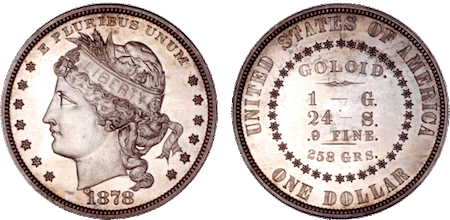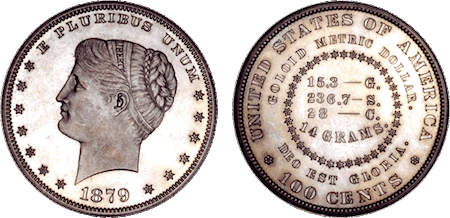
Over the years, the United States Mint has enjoyed many successes in coinage. The metric dollar, composed of goloid, was not one of them. Goloid was a material used for pattern metric dollar coins in 1878-1880 as a compromise between the gold and silver standards.
Gold vs. Silver
In 1792, Alexander Hamilton introduced the mint act, which put the United States on a bimetallic gold/silver standard, with the ratio of gold to silver value set at 15:1. Citizens could bring their gold and silver to the mint, where they could exchange it for coins.
The Crime of 73
In 1873, Ulysses Grant signed the Coinage Act, a bill putting the United States on the gold standard. Silver fans were upset, and referred to the act as the crime of ’73. In 1877, Dr. William Wheeler Hubbell, one of my fellow Philadelphians, was granted a patent for his invention of a new metal, goloid, which was composed of one part gold, 24 parts silver, and 2.5 parts copper. Intended for coins, the new material represented a compromise between the gold and silver standard and resulted in a new dollar coin that was smaller (and therefore more convenient) than the silver dollar. The recipe for the metal appeared on the reverse of the coin.
Metric dollar
Between 1878 and 1880, the mint produced pattern coins with rival obverse designs by William Barber and George Morgan. The coin below is by Morgan. The coin at the top of the page is by Barber.
Problems with the metric dollar
Unfortunately, the coins struck in goloid looked identical to coins struck in silver. Hubbell argued that goloid should not look like silver, but instead should exhibit a purple gold hue. The loss of the hue may have been due to the minting process of pickling the dies with acid. The coins also had a political problem. With silver prices plummeting, congress passed the Bland-Allison Act, which required the government to buy massive amounts of silver and mint them into what became known as Morgan dollars. The silver supporters had been placated. The silly compromise of the metric dollar became a whisper in history.